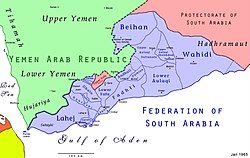Sultanate of Lahij
| Sultanate of Lahej | ||||||||||||||||
| سلطنة لحج | ||||||||||||||||
|
||||||||||||||||
|
Flag
|
||||||||||||||||
|
Map of the Federation of South Arabia, with Lahej at bottom left
|
||||||||||||||||
| Capital | Al-Hawtah | |||||||||||||||
| Religion | Sunni Islam | |||||||||||||||
| Government | Sultanate | |||||||||||||||
| Historical era | Aden Protectorate | |||||||||||||||
| • | Independence from Ottomans | 1728 1728 | ||||||||||||||
| • | British invasion | 1839 1967 | ||||||||||||||
|
||||||||||||||||
Lahej (Arabic: لحج Laḥij), the Sultanate of Lahej (Arabic: سلطنة لحج Salṭanat Laḥij), or, sometimes, the Abdali Sultanate (Arabic: سلطنة العبدلي Salṭanat al-‘Abdalī), was a Sheikdom based in Lahej in Southern Arabia. The Sultanate became self-ruled in 1728 and gained independence in 1740. In 1839, the Sultanate became Aden Protectorate of the British Empire, though nominally the 'Abdali Sultan retained his status. The Aden protectorate was briefly ruled again by the Ottomans during World War I, but regained by the British and absorbed into Federation of South Arabia in 1963. The 'Abdali dynasty was officially abolished in 1967, with the proclamation of South Yemen.
Lahej was sultanate of the 'Abdali dynasty. In 1740 the 'Abdali sultan became independent. The Sultanate of Lahej became an independent entity, from 1728 to 1839.
The Sultanate of Lahej lost its independence to the British, after the Royal Navy Aden Expedition attack in 1839. The Sultan signed several treaties with the British. The 1863 opening of the Suez Canal caused the formation of the Aden Protectorate
The sultanate was one of the original "Nine Cantons" that signed individual British protectorate agreements with Great Britain, that in 1869 were joined together to become the Aden Protectorate. The Suez Canal also opened in 1869.
...
Wikipedia


